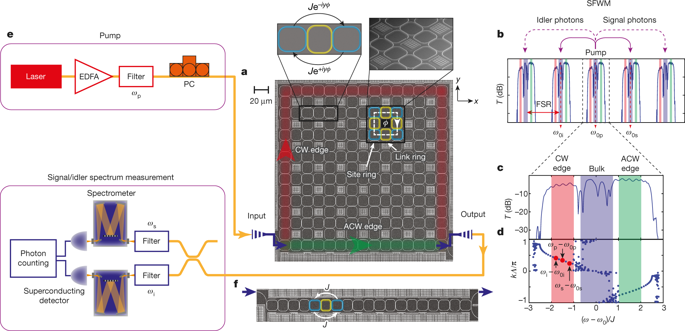Our official English website, www.x-mol.net, welcomes your
feedback! (Note: you will need to create a separate account there.)
A topological source of quantum light
Nature ( IF 50.5 ) Pub Date : 2018-09-01 , DOI: 10.1038/s41586-018-0478-3 Sunil Mittal , Elizabeth A. Goldschmidt , Mohammad Hafezi
Nature ( IF 50.5 ) Pub Date : 2018-09-01 , DOI: 10.1038/s41586-018-0478-3 Sunil Mittal , Elizabeth A. Goldschmidt , Mohammad Hafezi

|
Quantum light is characterized by distinctive statistical distributions that are possible only because of quantum mechanical effects. For example, single photons and correlated photon pairs exhibit photon number distributions with variance lower than classically allowed limits. This enables high-fidelity transmission of quantum information and sensing with lower noise than possible with classical light sources1,2. Most quantum light sources rely on spontaneous parametric processes such as down-conversion and four-wave mixing2. These processes are mediated by vacuum fluctuations of the electromagnetic field. Therefore, by manipulating the electromagnetic mode structure, for example with dispersion-engineered nanophotonic systems, the spectrum of generated photons can be controlled3–7. However, disorder, which is ubiquitous in nanophotonic fabrication, causes device-to-device spectral variations8–11. Here we realize topologically robust electromagnetic modes and use their vacuum fluctuations to create a quantum light source in which the spectrum of generated photons is much less affected by fabrication-induced disorder. Specifically, we use the topological edge states realized in a two-dimensional array of ring resonators to generate correlated photon pairs by spontaneous four-wave mixing and show that they outperform their topologically trivial one-dimensional counterparts in terms of spectral robustness. We demonstrate the non-classical nature of the generated light and the realization of a robust source of heralded single photons by measuring the conditional antibunching of photons, that is, the reduced likelihood of photons arriving together compared to thermal or laser light. Such topological effects, which are unique to bosonic systems, could pave the way for the development of robust quantum photonic devices.Topologically protected edge states realized in a square array of ring resonators are used to demonstrate a robust source of heralded single photons produced by spontaneous four-wave mixing.
中文翻译:

量子光的拓扑源
量子光的特点是独特的统计分布,这仅是由于量子力学效应才可能的。例如,单光子和相关光子对表现出的光子数分布的方差低于经典允许的限制。这使得量子信息的高保真传输和传感的噪声低于经典光源 1,2。大多数量子光源依赖于自发参数过程,例如下变频和四波混频2。这些过程由电磁场的真空波动介导。因此,通过操纵电磁模式结构,例如使用色散工程纳米光子系统,可以控制产生的光子的光谱3-7。然而,紊乱,这在纳米光子制造中无处不在,会导致设备到设备的光谱变化8-11。在这里,我们实现了拓扑稳健的电磁模式,并使用它们的真空波动来创建量子光源,其中产生的光子的光谱受制造引起的无序的影响要小得多。具体来说,我们使用在环形谐振器二维阵列中实现的拓扑边缘状态通过自发四波混合生成相关光子对,并表明它们在光谱稳健性方面优于拓扑平凡的一维对应物。我们通过测量光子的条件反集束来证明所产生的光的非经典性质和强大的预告单光子源的实现,即,与热光或激光相比,光子一起到达的可能性降低。这种玻色子系统独有的拓扑效应可以为开发稳健的量子光子器件铺平道路。 在环形谐振器的方形阵列中实现的拓扑保护边缘状态用于证明自发产生的预示单光子的稳健来源四波混频。
更新日期:2018-09-01
中文翻译:

量子光的拓扑源
量子光的特点是独特的统计分布,这仅是由于量子力学效应才可能的。例如,单光子和相关光子对表现出的光子数分布的方差低于经典允许的限制。这使得量子信息的高保真传输和传感的噪声低于经典光源 1,2。大多数量子光源依赖于自发参数过程,例如下变频和四波混频2。这些过程由电磁场的真空波动介导。因此,通过操纵电磁模式结构,例如使用色散工程纳米光子系统,可以控制产生的光子的光谱3-7。然而,紊乱,这在纳米光子制造中无处不在,会导致设备到设备的光谱变化8-11。在这里,我们实现了拓扑稳健的电磁模式,并使用它们的真空波动来创建量子光源,其中产生的光子的光谱受制造引起的无序的影响要小得多。具体来说,我们使用在环形谐振器二维阵列中实现的拓扑边缘状态通过自发四波混合生成相关光子对,并表明它们在光谱稳健性方面优于拓扑平凡的一维对应物。我们通过测量光子的条件反集束来证明所产生的光的非经典性质和强大的预告单光子源的实现,即,与热光或激光相比,光子一起到达的可能性降低。这种玻色子系统独有的拓扑效应可以为开发稳健的量子光子器件铺平道路。 在环形谐振器的方形阵列中实现的拓扑保护边缘状态用于证明自发产生的预示单光子的稳健来源四波混频。











































 京公网安备 11010802027423号
京公网安备 11010802027423号